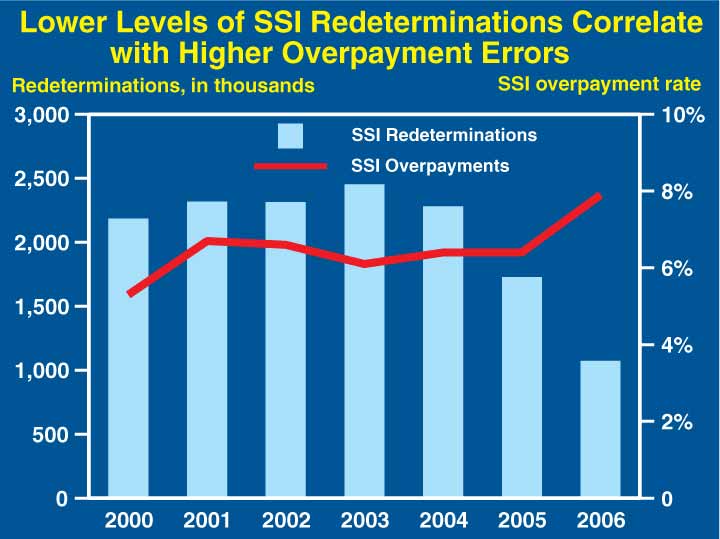SOCIAL SECURITY ADMINISTRATION
The President’s 2009 Budget will:
-
Support the President’s framework for Social
Security reform that strengthens the safety net for future generations,
protects those most dependent on Social Security, and offers workers
the opportunity of ownership through voluntary personal retirement
accounts;
-
Reduce wait times and cut backlogs in the disability
hearings process;
-
Increase program integrity efforts to ensure benefits
are provided to the right beneficiaries— preventing improper
payments; and
-
Increase productivity by two percent while enhancing
service to the public.
Strengthening Social Security
Enhancing Customer Service
-
Reduces wait times. Improves processing times and works to reduce the number of applicants
waiting for a decision in the Disability Insurance (DI) and Supplemental
Security Income (SSI) programs.
-
Continues ambitious initiatives to reduce the number
of disability appeals that are awaiting a decision from an Administrative
Law Judge.
-
Provides funding for projects that identify those
cases most likely to be allowed so that severely ill applicants can
begin receiving benefits on an expedited basis.
-
Increases the capacity to process disability appeals
by hiring additional Administrative Law Judges and support staff.
-
Boosts the overall productivity of hearings and targets
overtime to critical areas.
-
Improves service to the public. Assists more than 40 million visitors to nearly 1,300 Agency field
offices in communities across America.
|
Source: Social Security Administration Performance and Accountability Reports
 |
|
Major Savings and Reforms
-
Highlights the fiscal problems facing DI with a “funding
warning” to draw attention to the growing fiscal pressure that
the program will exert on the Federal budget.
-
Proposes legislation to synchronize the treatment
of retroactive DI payments with Old-Age and Survivors Insurance payments,
and to make additional modifications to the distribution of other
retroactive payments.
-
Proposes legislation to encourage children to stay
in school by lowering to 16 the age at which full-time school attendance
is a condition of entitlement for Social Security child’s benefits.
-
Eliminates the current self-reporting burden on individuals
and improves payment accuracy by proposing a mandatory system for
collecting data on pension income from non-covered State and local
employment.
-
Proposes to replace the existing complicated offset
with a uniform offset for DI beneficiaries also receiving workers’
compensation. The proposal would limit the length of the offset to
not more than five years.
Since 2001, the Social
Security Administration has:
-
Improved productivity by 15 percent, enabling the
Agency to provide more effective and timely services with fewer resources
than would otherwise be required.
-
Increased work opportunities for individuals with
disabilities.
-
Continued to work with other agencies to expand processes
that help employers verify work authorization of employees.
SOCIAL SECURITY ADMINISTRATION
(In millions of dollars)
| |
2007 Actual |
Estimate |
| 2008 |
2009 |
|
|
|
|
|
| Spending |
|
|
|
| Discretionary
Budgetary Resources: |
|
|
|
| Limitation on
Administrative Expenses (LAE) Base 1 |
9,298 |
9,745 |
10,327 |
| Office of the
Inspector General |
92 |
92 |
98 |
| Research and Development |
20 |
20 |
28 |
| Total, Discretionary
budgetary resources |
9,410 |
9,857 |
10,453 |
| |
|
|
|
| Total, Discretionary
outlays |
9,220 |
9,783 |
10,386 |
| |
|
|
|
| Mandatory Outlays: |
|
|
|
| Old-age, Survivors,
and Disability Insurance 2 |
581,518 |
610,426 |
645,136 |
| Supplemental Security
Income 3 |
36,021 |
41,338 |
43,302 |
| Special Benefits
for Certain World War II Veterans |
8 |
10 |
10 |
| Offsetting collections |
−2,957 |
−3,149 |
−3,116 |
| Legislative proposals |
— |
— |
−914 |
| Total, Mandatory
outlays |
614,590 |
648,625 |
684,418 |
| |
|
|
|
| Total, Outlays |
623,810 |
658,408 |
694,804 |
|
|
|
|
|
1 The LAE account includes
funding from the Hospital Insurance and Supplementary Medical Insurance
trust funds for services that support the Medicare program, including
implementation of Medicare Reform.
2 In 2007, Treasury refunded the
OASI and DI Trust funds $1,297 million due to the overpayment of voluntary
income tax withholding. This did not impact beneficiary payments.
The mandatory total does not include the refund.
3 Does not include the effect of State supplementation
offsetting collections.
|
 Skip Main Navigation
Skip Main Navigation

